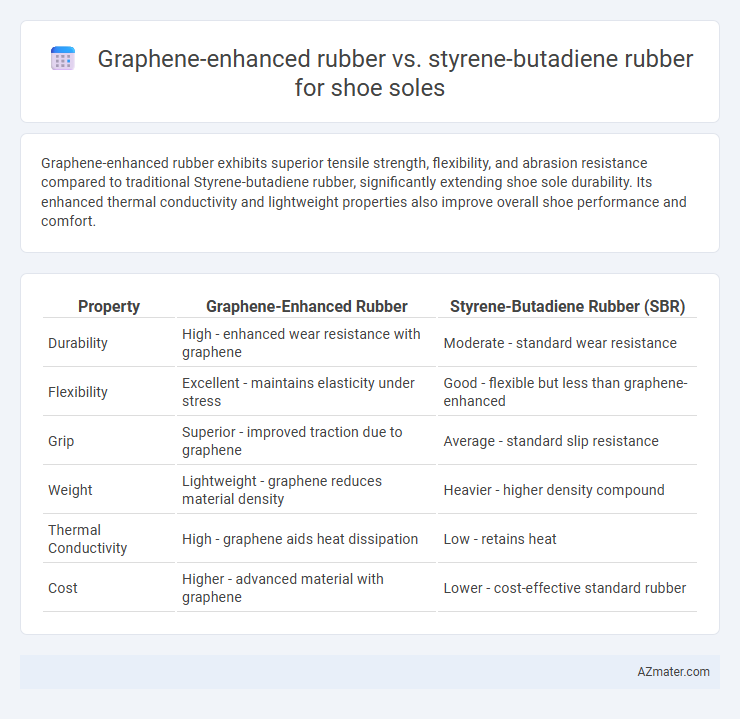Graphene-enhanced rubber exhibits superior tensile strength, flexibility, and abrasion resistance compared to traditional Styrene-butadiene rubber, significantly extending shoe sole durability. Its enhanced thermal conductivity and lightweight properties also improve overall shoe performance and comfort.
Table of Comparison
| Property | Graphene-Enhanced Rubber | Styrene-Butadiene Rubber (SBR) |
|---|---|---|
| Durability | High - enhanced wear resistance with graphene | Moderate - standard wear resistance |
| Flexibility | Excellent - maintains elasticity under stress | Good - flexible but less than graphene-enhanced |
| Grip | Superior - improved traction due to graphene | Average - standard slip resistance |
| Weight | Lightweight - graphene reduces material density | Heavier - higher density compound |
| Thermal Conductivity | High - graphene aids heat dissipation | Low - retains heat |
| Cost | Higher - advanced material with graphene | Lower - cost-effective standard rubber |
Introduction to Advanced Shoe Sole Materials
Graphene-enhanced rubber offers superior mechanical strength, flexibility, and wear resistance compared to traditional Styrene-butadiene rubber (SBR) used in shoe soles. The integration of graphene significantly improves abrasion resistance and thermal conductivity, resulting in more durable and comfortable footwear. These advancements address common performance limitations of SBR, positioning graphene composites as a next-generation material for high-performance shoe soles.
What is Graphene-Enhanced Rubber?
Graphene-enhanced rubber incorporates graphene, a single layer of carbon atoms arranged in a hexagonal lattice, into the traditional rubber matrix to significantly improve mechanical properties such as tensile strength, abrasion resistance, and elasticity. This composite material exhibits superior thermal conductivity and durability compared to conventional styrene-butadiene rubber (SBR), making it ideal for high-performance shoe soles requiring enhanced wear resistance and flexibility. The integration of graphene nanoparticles optimizes the rubber's molecular structure, resulting in lighter, stronger, and longer-lasting footwear components.
Overview of Styrene-Butadiene Rubber (SBR)
Styrene-Butadiene Rubber (SBR) is a synthetic elastomer commonly used in shoe soles for its excellent abrasion resistance and moderate aging stability. Its copolymer structure, combining styrene and butadiene monomers, provides a balance of durability, flexibility, and cost-effectiveness in footwear applications. SBR remains a widely adopted material due to its proven performance in comfort and slip resistance under various environmental conditions.
Mechanical Strength Comparison
Graphene-enhanced rubber exhibits significantly higher tensile strength and abrasion resistance compared to Styrene-butadiene rubber (SBR), making it ideal for durable shoe soles. The incorporation of graphene nanoplatelets reinforces the rubber matrix, enhancing elasticity and wear resistance without compromising flexibility. In contrast, SBR, while commonly used for its good abrasion resistance and cost-effectiveness, typically shows lower mechanical robustness under prolonged stress and extreme conditions.
Durability and Longevity Insights
Graphene-enhanced rubber significantly improves the durability and longevity of shoe soles compared to traditional styrene-butadiene rubber (SBR) by providing superior tensile strength and abrasion resistance. The incorporation of graphene enhances the material's resistance to wear and tear, extending the sole's functional lifespan under high-stress conditions. Studies indicate that graphene composites can increase the service life of shoe soles by up to 50%, making them a highly effective alternative to standard SBR in footwear applications.
Flexibility and Comfort Differences
Graphene-enhanced rubber outperforms Styrene-butadiene rubber (SBR) in shoe sole applications by offering superior flexibility, allowing soles to bend and stretch with enhanced resilience. This material's nanostructure provides improved energy absorption and efficient stress distribution, resulting in increased comfort during prolonged wear. In contrast, SBR, while durable, tends to be stiffer and less adaptive to foot movements, potentially causing reduced cushioning and comfort over time.
Traction and Slip Resistance Performance
Graphene-enhanced rubber significantly improves traction and slip resistance in shoe soles by increasing surface grip and durability at the microscopic level compared to traditional styrene-butadiene rubber (SBR). The incorporation of graphene enhances elasticity and friction properties, resulting in superior performance on wet and uneven surfaces. Studies show that graphene composites maintain consistent slip resistance under varying temperatures and wear conditions, outperforming SBR in both safety and longevity.
Environmental Impact and Sustainability
Graphene-enhanced rubber offers significant environmental benefits over traditional styrene-butadiene rubber (SBR) for shoe soles due to its higher durability and longer lifespan, reducing waste and resource consumption. The improved mechanical properties of graphene composites in rubber decrease the frequency of sole replacements, leading to lower carbon emissions associated with manufacturing and disposal processes. In contrast, SBR relies heavily on petrochemical resources and contributes more to environmental pollution through its shorter wear life and less efficient recyclability.
Cost-Effectiveness and Market Trends
Graphene-enhanced rubber offers superior durability and flexibility compared to traditional Styrene-butadiene rubber (SBR), resulting in longer-lasting shoe soles and reduced replacement frequency, which enhances cost-effectiveness despite higher initial prices. Market trends indicate a growing adoption of graphene composites in footwear due to rising demand for high-performance, sustainable materials driving innovation and premium pricing. Analysis of cost-benefit dynamics reveals that while SBR remains popular for budget-friendly options, graphene-enhanced rubber is gaining traction among mid-to-high-end brands emphasizing durability and advanced material technology.
Future Prospects in Footwear Technology
Graphene-enhanced rubber offers superior mechanical strength, wear resistance, and thermal conductivity compared to traditional styrene-butadiene rubber, promising longer-lasting and more durable shoe soles. Its enhanced elasticity and lightweight properties can lead to improved comfort and performance in athletic and casual footwear. Ongoing research aims to scale production and reduce costs, positioning graphene composites as a transformative material in the future of sustainable and high-performance footwear technology.

Infographic: Graphene-enhanced rubber vs Styrene-butadiene rubber for Shoe sole
 azmater.com
azmater.com